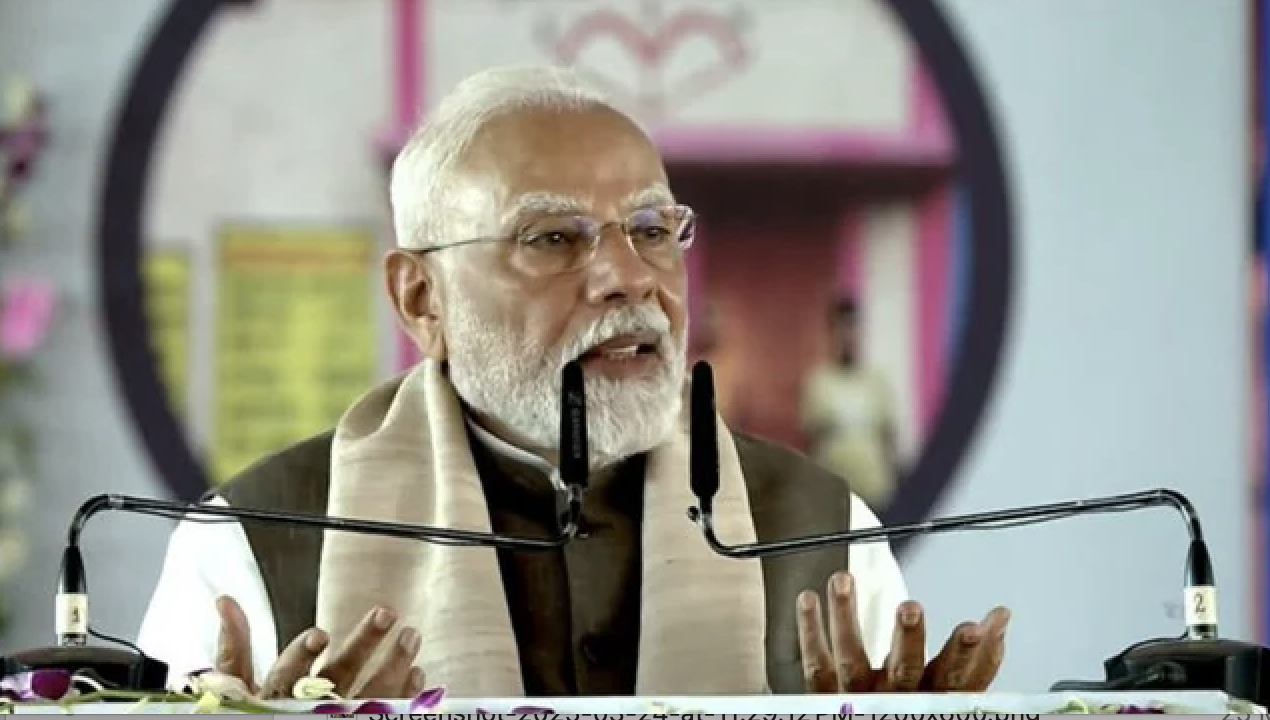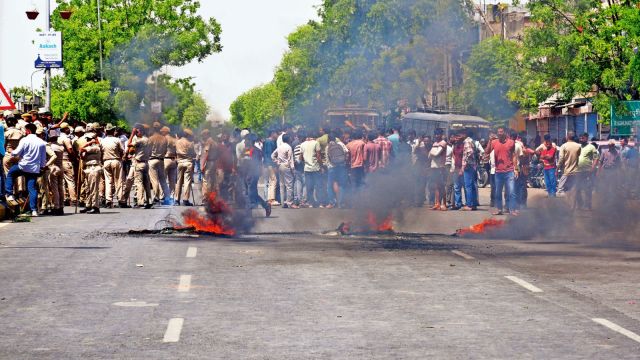
Kolkata: More than eight decades ago, in 1938, India saw the first comprehensive attempt at rewriting its history when Madhav Sadashiv Golwalkar, the second and most-influential sarsanghchalak (or helmsman) of the Hindutva organisation, the Rashtriya Swayamsevak Sangh (RSS), published his book, We Or Our Nationhood Defined.
“It is high time that we studied, understood and wrote our history ourselves and discarded such designed or undesigned distortions (regarding India’s history and antiquity),” Golwalkar wrote in the book, which has been to Hindutva forces what the Bible is to devout Christians. Thus, in the guise of correcting alleged distortions, began an initiative that historians today allege has grown into one of the biggest projects seeking to alter a country’s history.
On Sunday, January 30 – remembered nationally as the day of Mahatma Gandhi’s assassination – Marxist historian and globally-renowned scholar Irfan Habib identified Golwalkar’s book as the fountainhead of recent attempts to alter India’s history; an initiative he called ‘doctoring history’.
Habib’s remarks came during a speech he delivered at an online event titled ‘Doctored History: From Ancient Times till Today’, organised by the New Socialist Initiative, a Delhi-based collective.
In his book, Habib pointed out, Golwalkar propagated the RSS’s key theories about Indian history that Hindutva preachers have been trying to prove right ever since. And since there is no evidence to substantiate their claims, these preachers have taken it upon themselves to fabricate evidence themselves.
These initiatives, according to Habib, reached their peak when the Bharatiya Janata Party’s (BJP) Atal Bihari Vajpayee was prime minister and have, once again, gained traction since Narendra Modi, also of the BJP, came to power in 2014.
Premised on the supposed superiority of the Aryan race, the myths that Hindutva activists try to propagate revolve around the claim that the Indus Valley civilisation was a part of the Aryan Hindu culture and, therefore, that Aryans are indigenous to India, supplementing the Hindutva narrative that Muslim rule was foreign to India and that it made no notable contribution except for harm.
Calling the whole theory “absurd”, Habib said that neither archaeological, linguistic nor genetic evidence supports any of their claims.
“Historical tradition in India is very old, spanning from works in Sanskrit like the Harshacharita and Rajatarangini to, of course, the Persian chronicles, records and books on administration like Ain-e-Akbari, and finally to those of the colonial period,” Habib said.
Habib further noted that, be it the Indo-Persian chronicles or the Harshacharita (a biography in praise), these works always paid some regard to accuracy and actual facts. “We can use these texts to reconstruct the Indian history of that time. What is happening today, what has been aptly called ‘doctoring history’, is history that has no basis, practically, in facts,” he said.
“The race theory has been discredited all over the world but is now the reigning doctrine as far as ‘official’ historiography (in India) is concerned, as shown, for instance, in the University Grant Commission’s (UGC) syllabus for the bachelor’s course in history,” said the 90-year-old historian.
The Aryan question: facts versus fiction
From a reading of Golwalkar’s book, a few statements emerge as central to the Hindutva idea of India as well as to the entire ideological sphere of Hindutva culture and politics.
“We – Hindus – have been in undisputed and undisturbed possession of this land for over eight, or even ten, thousand years before the land was invaded by any foreign race,” is one such sentence. Golwalkar even writes, “Hindu, that is Aryan,” implying that Aryans and Hindus are one and the same.
Without citing any particular reference, he wrote that “orientalist scholars have ascertained” that the Bhagavad Gita “must be about 1,500 – 2,000 years prior to Buddha’s birth” and since Buddha was alive around 600 BCE, the Mahabharata has to be “at least 4,500 – 5,000 years old.”
And since “…the Mahabharat depicts a highly organised, elaborate, civilised society, at the zenith of its power and glory,” Golwalkar wrote, “we must say that we must have lived and progressed many times in that period before we could attain that superb social structure, sung in that immortal song.”
“What authority is there to prove our immigrant nature?” Golwalkar continued. “The shady testimony of Western scholars? Well, it must not be ignored that the superiority complex of the ‘White Man’ blurs their vision.” He insisted that “the very first page of history records our existence as a progressive and highly civilised nation – the only nation in the then world… the land of the Hindus.”
This theory puts forth that the Indus Valley civilisation was part of the Aryan-Vedic civilisation. The recent, controversial calendar published by IIT Kharagpur had tried to establish this very theory.
Habib denounced the entire theory as baseless, first pointing out that all scientific research has concluded that the modern human race, the Homo sapiens, evolved from the part of the world that is now recognised as Africa and spread out to different parts of the world from there, as did the species that preceded it; the Homo erectus.
According to Habib, as far as linguists are concerned, the term ‘Arya’ applies only to India and Iran and to only the Indo-European set of languages of the earlier texts, such as the Rig Veda and the Avesta. In early Sanskrit texts, the word ‘Arya’ was used to mean ‘respectable/honourable’. In the Dharma Shastra, it was used to refer to three higher castes in the hierarchy; the Brahman, Kshatriya and Vaishya. Buddhists used it to mean ‘noble’.
Notably, Golwalkar, too, acknowledged that Iran was originally called ‘Aryan’. In another book, titled Bunch of Thoughts, Golwalkar wrote: “Iran was originally Aryan. Its previous king Reza Shah Pehlavi was guided more by Aryan values than by Islam. Zend Avesta, the holy scripture of Parsis, is mostly Atharva Veda.”
However, he put this fact forward to argue that Iran was, in fact, part of ancient India – which forms a part of the Hindutva theory of ‘Akhand Bharat‘; an India that included regions from Iran in the west to Myanmar in the east. In short, India was constructed as the place from where civilisation spread.
Habib, however, questioned the RSS’s “very fixation” with the Aryans.
“What is the charm in being Aryas?” he asked, adding, “If you look at the writings of the NCERT textbooks of the period I am mentioning – of course, we have gone much beyond that in the UGC syllabus – there is extreme annoyance at any suggestion that Aryas came from outside. They (must have) spread out from India.”
He said that the UGC syllabus included pre-history but made no mention of human migration out of Africa.
“Linguistics had long established that what is called the Aryan set of Indo-European languages, rising out of Sanskrit and Avestan (Iranian), was a late version of Indo-European languages. They were the farthest, practically, from proto-Indo-European languages. Then, there came the archaeological evidence – the horse evidence. Communities that had horses migrated from Kazakhstan and the Russian steppes into the southern parts of Central Asia, then across Afghanistan into Iran and India. You can trace it through horse bones and depictions of horses. This is now being reinforced by genetic evidence, which places this migration, notably of males, between 2,000 – 1,500 BCE, which was also the chronology established by archaeologists,” Habib said.
He also said that the Hindutva ideologues wrongly create a hullabaloo around Aryans being called ‘invaders’. Historians have spoken of ‘migration’ and not ‘invasion’, he said.
“Nobody is saying that the Aryans’ was a state that invaded India; we are talking about migrations and tribes, whose existences is attested to by the hymns of the Rig Veda and their movement; and we are talking about the Dravidian influence which comes into Indo-Aryan languages in India, but is absent in Iran,” he said.
Attempts to declare the Aryan civilisation in India as having predated Indus Valley “turn history upside-down,” Habib said, “because there is no evidence of horses in the Indus civilisation, none at all, and Rig Veda shows us a community in which horses were very important. This kind of invention cannot be acceptable to any serious historian.”
The Dravidian question
Habib argued that the identifiable Dravidian influence in the Indo-Aryan language is normal because the latter group, having been brought in by migrants, would certainly have the influence of other, pre-existing languages in them.
“The linguistic study is totally assured. But there is a tirade against Dravidian influences, which is very curious because Dravidians are also Indians. What is the harm if there is any Dravidian influence in the Rig Veda? An absolute, racist ideology is at work when it comes to the Indus Valley civilisation and it is very central to the doctored history of India which the RSS produces because they are trying to establish a fantastic chronology,” he said.
Accepting Dravidian influence would bust the theory of Aryan supremacy and their being indigenous to India. If Dravidians knew how to write before the Aryans, how could the latter be treated as superior?
Notably, it is on the basis of this indigenous Aryan understanding that the RSS and all its affiliates call India’s tribal population ‘Vanvasi’ (literally, forest dwellers) instead of Adivasi (literally, original inhabitants); an extension of their denial of India’s non-Aryan past.
According to Habib, the fact that the Indus civilisation had a written script, ideographs and pictographs has been “very troublesome” for Hindutva propagandists, since there is no evidence of Aryans being able to write until the Ashokan edicts (between 268 and 232 BCE). Moreover, if any earlier writing existed in southern India and Sri Lanka, it was in the Dravidian language.
“We can’t read it (the Indus script) and it’s certainly not Sanskrit. It has been stressed so many times that the seals (of deities) show – because the date is there – that they can’t be Vedic deities. They are zoomorphic, not anthropomorphic; they are based on animal forms, not human forms. The Shiva seal is also not at all Shiva because the animals shown are not cattle but wild animals. Therefore, it has long been held by every serious archaeologist that the Indus civilisation is pre-Aryan,” he said.
Habib also said there no possible link has been discovered between the Indus pictographs and Sanskrit, but the former has two “very important links” with proto-Dravidian language – the fish sign and the arrow sign. He said that the fish, in proto-Dravidian, refers to both fish and stars, rather than meaning ‘god’. “That will explain the very fecund way in which the fish sign appears in the Indus civilisation. The position of the arrow signs in the (Indus) texts suits the positions worked out for it in proto-Dravidian languages.”
Doctoring projects
Apart from the initiatives by the UGC and the NCERT under the BJP’s rule, Habib also referred to the works by RSS-linked writers, some of whom were bona fide archaeologists.
Speaking of the late V. S. Wakankar (credited with discovering the Bhimbetka rock shelters), who he described as ‘an RSS historian’, Habib said Wakankar placed the Rig Veda in 8,000 BC, which was absurd. “The Rig Veda shows agriculture – wheat cultivation, barley cultivation, flour and horse domestication. All were absent in 8,000 BCE. How could the Veda belong to that time?” he asked.
Referring to B. B. Lal, a former director general of the Archaeological Survey of India, Habib said that Lal placed the Satapatha Brahmana in 4,500 BC – “with some fantastical interpretation of astronomical data” – which would automatically place the Rig Veda in a much earlier time period.
Habib also referred to P. N. Oak’s series of writings in the RSS publication, Organiser, which started in the 1960s and claimed that every Mughal building was actually built by the Hindus. “This led historian R. C. Majumdar, whom I greatly respect as a historian but was certainly a member of Hindu Mahasabha, to break all connections with the Organiser. He considered Oak’s writings as ‘madness’ and said he could not have any relation with Organiser if this went on. The RSS decided to continue publishing Oak’s pieces,” Habib said.
He also cited an article written by B. N. Puri in 1980 which claimed that Porus defeated Alexander the Great as well as K. C. Verma’s that the Rig Veda must have been written before 2,200 BCE as being on the basis of “ridiculous logic”.
“The main aim is to put the Rig Veda well before the Indus civilisation to Aryanise and Hinduise the latter. Historical and archaeological evidence does not matter, it is just declarations. With the same aim, they try to rename ‘Indus’ as the Saraswati civilisation,” he said.
This story first appeared on thewire.in






